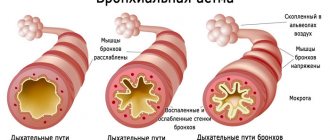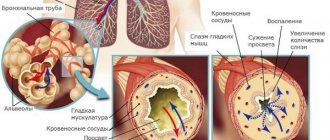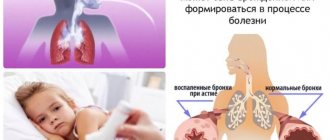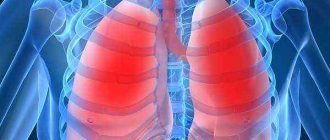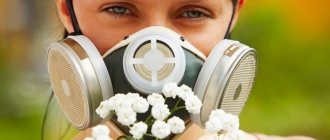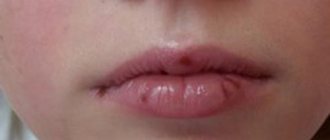Rehabilitation for bronchial asthma allows the patient to go through all the intermediate stages of the disease, maximizing the capabilities of his own body.
The disease bronchial asthma, as a rule, is chronic, characterized by an exacerbation stage and short-term remissions. Therefore, a specially developed plan is used. The optimal rehabilitation time is at least 2-4 months, depending on the severity of bronchial manifestations.
What kind of disease is this
Bronchial asthma is a chronic inflammatory disease of the airways involving a variety of cellular elements, primarily eosinophils, mast cells and T-lymphocytes.
Bronchial hyperreactivity and bronchospasms are characteristic; airway obstruction is reversible, which is a hallmark of this disease.
The disease often develops against the background of other allergic diseases, so bronchial asthma is often accompanied by:
- allergic rhinitis;
- hay fever;
- allergic dermatitis;
- hives;
- Quincke's edema.
Also, the occurrence of asthma is due to genetic inheritance from parents. The disease is more common among children than among adults.
Contribute to the development of the disease:
- deterioration of the environmental situation and an increase in allergens in the air;
- synthesis of new substances that are highly allergenic;
- eating canned food;
- the spread of immunodeficiency conditions among the population, contributing to the long-term persistence and multiplication of a viral infection within the human body.
In severe cases and untimely provision of assistance to patients, deaths are possible due to the closure of the lumens of the bronchi during attacks of suffocation.
Features of the course of the disease
On the right in the diagram, the narrowing of the bronchi is indicated by arrows.
Bronchial asthma is a disease that is based on a constant inflammatory process in the respiratory tract, which usually develops against the background of allergic diseases in people predisposed to the latter. Bronchial sensitivity in patients is significantly increased. This is manifested by attacks of suffocation, as well as respiratory discomfort, which is manifested by a dry cough, shortness of breath and so-called wheezing, sometimes audible even at a distance. All these phenomena are caused by a transient, that is, temporary and reversible, narrowing of the respiratory tract in response to a provoking factor
Such factors can be physical activity, strong emotions, the use of non-hormonal anti-inflammatory drugs, inhalation of cold air, dust, animal hair and other allergens.
Along with an increase in the reactivity of the mucous membrane of the bronchi of different sizes to irritating effects, patients often also experience changes associated with the functioning of the immune, nervous and endocrine systems
This means that such patients need to be examined carefully, focusing not only on one breathing apparatus
The nervous system participates in the development of asthma in the following way: the influence of its parts, which use the substance acetylcholine to transmit impulses, increases, which leads to broncho-obstruction - narrowing of the lumen of the respiratory tract.
All types of immunological reactions play a role in the inflammatory process in the mucous membrane of the respiratory tract. Special cells migrate to the area of inflammation and release special substances called inflammatory mediators. The latter support the process permanently. These include:
- Histamine.
- Prostaglandins.
- Leukotrienes.
The diagram shows a mast cell with granules containing inflammatory mediators.
Physical rehabilitation for bronchial asthma is aimed mainly at reducing inflammation in the walls of the bronchial tree, reducing the reactivity of the bronchi, which leads to a reduction in asthma attacks and a reduction in its symptoms in patients with severe forms of the disease, when the latter bothers them even in the periods between attacks.
Bronchial asthma can develop under the influence of the following factors:
- Hypersensitivity to allergens such as pollen, dust, wool and many others.
- Individual intolerance to certain drugs.
- Hereditary factors.
- Previous respiratory diseases.
- Bad habits, such as smoking.
- Increased emotional and physical stress.
There are several stages in the development of bronchial asthma.
- Practically healthy person. There are no clinical signs of the disease. However, there are already a number of disorders that determine predisposition to this disease.
- Preasthma. This stage is characterized by a set of signs that appear in a person that indicate an increased risk of developing the disease. It has been established that asthma may develop in approximately 20-40% of such patients. There are a number of respiratory system diseases that can trigger the onset of asthma. According to statistics, 38% of patients with symptoms of pre-asthma had relatives with asthma. Extrapulmonary manifestations of allergies, such as urticaria, Quincke's edema, vasomotor rhinitis, also give reason to suspect a patient's predisposition to asthma. Also at risk are patients with elevated levels of eosinophils in the blood and sputum.
- Severe bronchial asthma, in which an almost asymptomatic course of the disease alternates with periodic attacks. This stage of the disease is characterized by typical signs of the disease, such as suffocation, coughing fits, etc. This stage is divided into several periods, based on the intensity of the manifestations of the disease.
In the absence of clinical symptoms of bronchial asthma, and also if there have been no exacerbations or asthma attacks for a long time, we can talk about the onset of a period of remission.
Why does it appear
Bronchial asthma, like other diseases, has specific causes and does not appear out of nowhere.
In this case, external and internal factors play an important role in the development of the disease, the combination of which triggers the pathological process.
Internal factors:
- genetic predisposition of the body to atopic reactions , that is, to increased secretion of antibodies when exposed to allergens. Half of patients with asthma have concomitant atopic diseases;
- predisposition to bronchial hyperreactivity , manifested in increased spasm of smooth muscle cells upon contact with allergens, is associated with the release of antibodies in the body;
- genetic predisposition to asthma, almost half of patients have it;
- In boys, asthma occurs more often in childhood due to the narrow lumen of the airways, and in adulthood women are more likely to suffer;
- violation of arachidonic acid metabolism caused by genetic changes.
External factors:
- influence of household allergens:
- house dust;
- dander and pet hair;
- food for aquarium fish;
- molds and yeasts;
- ticks.
- influence of external factors leading to hay fever:
- tree pollen;
- flower pollen.
- professional antigens;
- food allergens:
- citrus;
- chocolate;
- egg white;
- nuts, especially peanuts;
- Fish and seafood;
- honey;
- mustard;
- cow's milk and dairy products;
- bright vegetables and fruits.
- atmospheric allergens:
- dust;
- smog outside;
- accumulation of gas combustion metabolites in the kitchen and distribution throughout the house.
- viral and bacterial infection.
- medications:
- antibiotics;
- aspirin; and NSAID drugs;
- serums;
- vaccines;
- enzyme preparations;
- preparations for diagnostic measures.
The development of the disease may be due to the combined influence of various factors on the body.
Why is rehabilitation needed?
Like other pathologies, bronchial asthma is caused by a number of reasons. In this situation, a special role is played by external and internal aspects, the simultaneous occurrence of which triggers a complex pathological process.
In order to resume all vital functions as a result of the negative impact of the disease on the body, it is necessary to follow special rules that help reduce the regularity of spasms and mucus production. Only then will the patient feel normal and feel fully healthy. A person must take a rational approach to choosing a place to work so as not to encounter allergens.
During the rehabilitation process, children need to pay special attention to preventing exacerbations. Persistent clinical manifestations occurring in the respiratory system will lead to serious consequences
Activities for the recovery of patients are carried out in a hospital setting during an exacerbation, in a clinic, as well as at resorts and on an outpatient basis.
Both specialists and patients work together to make every possible effort for recovery. Otherwise there will be no result. The patient’s unquestioning compliance with all doctor’s recommendations is of great importance. Let's look at what types of rehabilitation there are.
What does rehabilitation for bronchial asthma include?
Rehabilitation is a set of measures aimed at restoring all functions of the patient.
For bronchial asthma, measures are prescribed that should reduce the frequency of bronchospasms and sputum synthesis, then the patient will feel good and feel like a healthy person.
Rehabilitation also includes rational employment.
Rehabilitation of children with bronchial asthma pays special attention to the prevention of attacks, so that attacks occur as little as possible.
Repeated inflammatory processes in the bronchial tree will lead to irreversible changes and the development of a more severe disease.
The same activities are held for children as for adults.
Photo: exercise therapy
Rehabilitation is carried out:
- in the hospital during an exacerbation;
- in the clinic during remission of the disease;
- in sanatoriums and resorts;
- at home.
To restore health, efforts must be made by doctors and the patient himself, otherwise there will be no effect from the treatment, so how the patient follows the doctor’s instructions and exercises independently plays a big role!
Drug therapy
When performing rehabilitation, physiotherapeutic techniques are applied to the patient in conjunction with drug therapy. This allows you to most effectively relieve obstructive disorders. As a rule, for such patients it is recommended to use aerosol drugs in special cans or liquid solutions that are inhaled using a nebulizer.
A positive effect on bronchial drainage function is observed during the use of electrophoresis with the addition of 2% potassium iodine. In some situations, a positive drug effect is observed with electrophoresis with 5% calcium chloride solution.
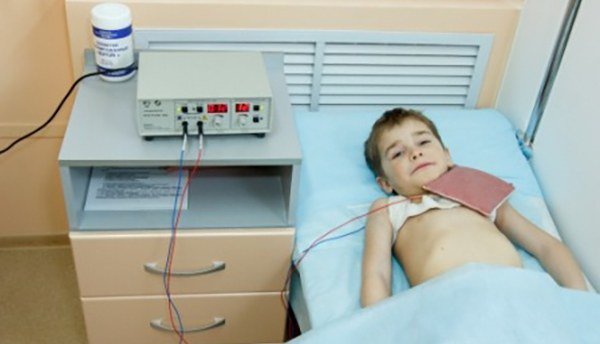
The most promising drugs to combat bronchial asthma include reflexology, breathing exercises, comprehensive physical education and drug therapy. The complex of these measures contributes to the rehabilitation not only of patients with asthmatic syndrome, but also strengthens the body’s immune forces.
It should be noted that rehabilitation of bronchial diseases is aimed only at reducing negative manifestations and enhancing the adaptive abilities of the patient’s body. Unfortunately, there is no method for 100% relief from bronchial asthma.
Methods
Rehabilitation includes:
- physical exercise;
- massage;
- breathing exercises;
- strengthening the immune system;
- drug therapy;
- climatotherapy.
Physical exercise
Physical rehabilitation for bronchial asthma includes a set of exercises that promote:
- strengthening the chest muscles;
- normalization of the nervous system;
- increasing the body's endurance;
- improving mental state by improving brain function;
- improving blood circulation throughout the body;
- improvement of lymph flow;
- improving metabolic processes;
- stimulation of the hormonal-humoral mechanism.
Exercises should be carried out during the period of remission, when there are no attacks. Classes must be supervised by an instructor.
At the beginning, light exercises are performed, when the instructor determines the patient’s endurance and physical fitness. The exercises gradually become more complex when exercises with a stick and ball are added.
Increased blood circulation and lymph flow ensures faster resorption of accumulated exudate in the bronchi.
Normalization of the nervous system leads to a decrease in the tone of smooth muscle cells in the bronchial tree. You cannot carry out exercises and hold your breath, so as not to provoke an attack of suffocation.
After classes, you should take a shower, but the water temperature should not differ much from room temperature. Cold or hot water can trigger an attack.
Video: Doctor's advice
Massage
A drainage massage is performed to help remove mucus from the bronchi.
Also, touching the skin stimulates the brain and respiratory center, which leads to reflex coughing attacks.
Massage must be combined with other activities and carried out as a consolidating stage during rehabilitation. The duration of one session is up to 15 minutes.
Massage is performed from the back and chest:
- The movements should be from the ribs to the back of the head.
- It is necessary to warm up all the muscles of the back and shoulder girdle.
- On the chest, carefully work with the nipple area and heart.
- It is necessary to carry out the following procedures:
- stroking;
- kneading;
- vibrations;
- trituration.
- Finally, carry out stroking.
- You can do patting.
- Allocate 5-6 minutes to the back and chest area.
Due to vibration and patting movements, sputum and mucus are separated from the bronchial tree. The criterion for the effectiveness of massage is the patient’s cough and better expectoration.
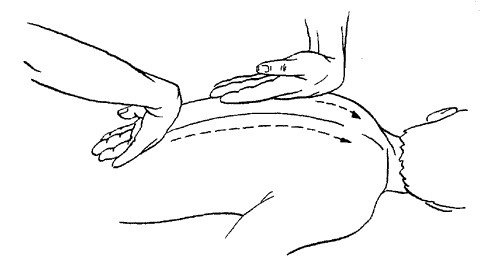
Photo: Direction of movements during massage
The effect of massage on the body:
- improved blood circulation;
- improvement of lymph outflow;
- stimulation of the nervous system;
- relaxation of the body;
- improvement of metabolic processes;
- strengthening the muscular system at the site of massage.
Breathing exercises
Breathing exercises will help the patient strengthen the diaphragm and clear the airways of accumulated harmful substances.
After a course of exercises, the walls of blood vessels are strengthened, which will ensure less penetration of antigens and inflammatory mediators through them.
Exercises:
- "Awakening". Lying in bed, bend your knees and pull them towards your chest, while exhaling. Perform immediately after sleep.
- Take a vertical position and, while inhaling, inflate your stomach.
- Breathe by closing your right and left nostrils alternately.
- Blow up balloons.
- Exercises with sounds, when, while exhaling slowly, you pronounce sibilants or consonants. The exercise is performed standing.
- Blow through the straw into a container of water, taking a deep and slow breath.
Read what allergic asthma is. How is exercise therapy performed for bronchial asthma? Details here.
Strengthening the immune system
Hardening the body helps to cope with any disease.
Only in this case you need to remember that excessively cold or hot temperatures can provoke an attack of suffocation.
It is better to take immunostimulating drugs after the recommendation of a doctor; you do not need to take them yourself.
Physical therapy and massage also help strengthen the immune system.
Medication
Medicines are prescribed by a doctor to reduce and prevent attacks.
Patients with asthma are doomed to constantly take medications until the attacks and symptoms completely disappear.
Preparations:
- Anti-inflammatory therapy:
- membrane stabilizing drugs;
- antileukotriene drugs;
- inhaled glucocorticosteroids, which are basic drugs for the treatment and prevention of attacks;
- systemic glucocorticosteroids when inhaled ones do not help.
- Bronchodilator therapy.
- Antibacterial therapy.
- Antihistamines.
- Enterosorbents.
Treatment is selected individually, depending on the characteristics of the body and the severity of asthma.
Climatotherapy
Being in clean air in sanatoriums and resorts has a beneficial effect on the condition of the respiratory system.
The influence of allergens and the release of antibodies in the body decreases, therefore, the frequency of attacks decreases.
How to make a plan and what it consists of
The rehabilitation plan is drawn up based on the data obtained:
- patient's medical history;
- patient examination data;
- clinical trial data;
- data on the effectiveness of previous therapy.
The severity of the patient is determined, after which the doctor decides where and how rehabilitation will take place:
- severe degree and attacks of suffocation are treated in a hospital until the attacks subside;
- mild form and moderate form - observation of health status in the clinic.
The prescription of rehabilitation methods also depends on the severity of the patient. For example, physical exercise will be suspended during an exacerbation, and after attacks will begin again with light loads.
Useful tips
- follow a hypoallergenic diet, because allergens in food have strong allergic properties, especially proteins;
- do not interrupt prescribed therapy voluntarily if symptoms have decreased or disappeared. This may be a calm stage, always consult with specialists;
- Avoid active and passive smoking!
- get rid of all bad habits, because he needs strength to fight the underlying disease;
- if you have a sick child in your family, then try to lead the same lifestyle with him and eat the same foods so that he does not feel different from those around him;
- Don’t forget your inhalers, they may be needed when you need them most;
- Do not skip taking medications.
The procedure for taking rehabilitation measures
- When starting rehabilitation, it is important to determine the order of rehabilitation measures: Provide a safe environment by getting rid of allergens in places of permanent residence.
- Smoothly, within 2-3 weeks, switch to a new diet, completely eliminating prohibited foods and balancing the menu.
- Once you get used to the changed diet, add physical therapy. The main thing at this stage is to get used to regular exercise, this will take 2 weeks.
- Monitor your breathing during exercise therapy, gradually paying more and more attention to it. And finally, include breathing exercises.
- Now, if you feel well, you can begin physical therapy. The order and timing of the procedures will be determined by the doctor. He can also offer you a different order of rehabilitation measures, selecting an individual recovery program for you.
Features of restoring children's health
The children's body is characterized by a greater ability to restore damaged structures, so recovery in children is possible.
But do not forget about the instability of the immune system of babies, which can lead to the appearance of concomitant allergic diseases if treatment is not followed.
Parents should exercise and massage their children in their free time, as this is much better than taking medications.
Only the child should enjoy the activities, so teach your child to physical education.
With constant exercise, the disease will be overcome faster.
Children are susceptible to infectious diseases in kindergarten and school, which can aggravate the condition, so during illness, protect the child from unnecessary and provoking contacts.
Find out how breathing exercises work for bronchial asthma according to Strelnikova. What should be the diet for bronchial asthma in adults? Read on.
How to provide emergency assistance during an attack of bronchial asthma? Find out more.
Fulfilling doctor's orders
An important component of the nursing process for bronchial asthma is basic therapy. The nurse must not only strictly follow the doctor’s recommendations, but also draw the patient’s attention to how important it is to take medications. He is also informed about the possible side effects of drug therapy.
In addition, the nurse:
- teaches the patient the skills of keeping a self-monitoring diary and using inhalation devices;
- accompanies the patient to diagnostic procedures;
- provides all possible psychological support to the asthmatic and his relatives;
- closely monitors the patient’s condition in order to promptly recognize the side effects of medication use;
- notifies the attending physician about the ineffectiveness of the prescribed therapy (if this occurs) and asks to adjust the prescription.
The duties of the nurse include regular surveys of the patient regarding his well-being. In addition, she daily:
- listens to the patient's complaints;
- measures his body temperature;
- determines the number of heart contractions and breathing rate;
- controls the condition of an asthmatic during attacks of shortness of breath and cough.
If the patient's condition worsens, the attending physician must be notified immediately.
With proper organization of nursing care, treatment ends with an improvement in condition, followed by discharge from the hospital. However, in order to avoid exacerbations and complications, even when at home, the patient must follow all the doctor’s recommendations.
Preventive measures
Prevention is the key to health, so you need to take care of yourself and your loved ones.
What to do:
- If possible, avoid contact with allergens:
- leave when plants are blooming;
- follow a hypoallergenic diet;
- quit your job if you develop asthma because of it;
- Be careful with medications, always remember about allergies.
- Strengthen your body by doing physical exercise.
- Take your medications on time.
- Walk in the fresh air more often, perhaps it is better to move to another place.
- Treat all diseases caused by viruses and bacteria to avoid complications.
- Maintain room temperature and water temperature when showering.
- Do not drink alcoholic beverages.
- Visit your doctor periodically.
Bronchial asthma is treatable if you make an effort. It is not a death sentence, so when you hear this diagnosis, don’t be scared, but tune in to recovery and take care of yourself! Be healthy!
Previous article: Urticaria pigmentosa Next article: Nutrition for bronchial asthma



